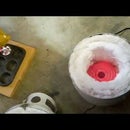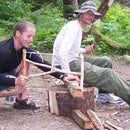Introduction: Build a Solar Hot Dog Cooker
This is a parabolic cooker I built a while ago, so unfortunately I can't show step by step photos of it's construction. However, it's relatively easy to see how it was put together.
It makes a great science project. Unlike most, you'll actually get some use out of it afterwards. Some of the principles it demonstrates are:
1. Optics: focusing parallel rays of incident light through the use of a parabolic mirror.
2. Energy transformation: light to heat
3. Renewable energy: solar power
Materials:
2 - 2x4 cut to 17" length (ends)
2 - 1/2" plywood cut to 1ft x 4ft (sides)
1 - 5/16" plywood cut to 18" x 4ft (backing)
1 - sheet of silvered mylar or tin foil cut to 17" x 4ft (mirror)
2 - 1/2" plywood cut to 3/4" x 12" (skewer mounts)
1 - 1/4" wooden dowel with a sharpened point (skewer)
Plus miscellaneous fasteners and spray adhesive
Tools:
Jig saw
Power drill
Drill bits
Screw driver bits
Step 1: Optics 101: Focussing Light With a Parabolic Mirror
In order to focus parallel rays of incident light on a fixed point you need a parabolic mirror. There are a few different ways to generate a parabolic curve, but the easiest to understand (though not necessarily the easiest in practice) is simply doing the math.
The formula for a parabola is:
Y = X2/(4F)
Where:
X is the horizontal distance from the origin
F is the focal distance (a design choice)
Y is the vertical distance to the curve at any point X
See the image below for a graphical representation.
Step 2: Cut the Sides to a Parabolic Profile
I designed my parabolic cooker with a focal distance F of 18 inches. Thus my formula was:
Y = X2/72 (where both X and Y are in inches).
I used a spreadsheet to calculate and plot the value of Y for all values of X from -24" to +24".
Y is the same whether X is positive or negative, so I've only shown Y values for X values from 0 to 24 here). Those values are:
X - Y
0 - 0.000
1 - 0.014
2 - 0.056
3 - 0.125
4 - 0.222
5 - 0.347
6 - 0.500
7 - 0.681
8 - 0.889
9 - 1.125
10 - 1.389
11 - 1.681
12 - 2.000
13 - 2.347
14 - 2.722
15 - 3.125
16 - 3.556
17 - 4.014
18 - 4.500
19 - 5.014
20 - 5.556
21 - 6.125
22 - 6.722
23 - 7.347
24 - 8.000
Draw a grid with 1" spacing on one of the 2 sheets of plywood to be used for the sides. similar to that shown below, and plot the curve. Then simply cut along the curve with a jig saw. You can repeat the process on the second sheet or use the first sheet as a template to trace the curve onto the second (or if you are a brave enough, you can attempt to cut them both at the same time... clamp them together well first).
Step 3: Assemble the Parts
Attach the sides to the 2x4s that will become the ends. I used 3" #10 screws because they were handy, but 2" screws are probably long enough.
Draw a pencil mark on each side at the origin of the parabolic curve.
Draw a line across the center of the backing (the 18" x 4ft sheet of 5/16" plywood) dividing it into two halves (each 18" x 2ft).
Line up the backing with the sides and put a small screw (I used 3/4" #6 screws) through the center line on the back and into each side at the origin marks you made.
Every 6" or so, put another screw through the backing into each side until you have attached the backing to the sides along the entire length of the sides (bend the backing to match the shape of the sides as you go).
Now glue your mylar or tin foil to the inside surface of the backing. Spray adhesive works well. Try to smooth out the surface as much as possible. Any little wrinkles will reduce the efficiency of the cooker. You can see that I wasn't that careful myself.
Step 4: Attach the Skewer Mounts
The parabolic mirror you have created has a focal distance of 18", but the sides are only 12" wide. I designed it this way (It could have just as easily been made with sides 18" wide) so it wouldn't be so big. Therefore, you need a way of holding your skewer 6" away from the top edge of each side.
I did this with a couple pieces of 1/2" plywood cut to about 12" x 3/4", but you can use any material you have available. Screw these pieces to the center of each side so they stick out a little over 6" to hold the skewer. If you want you can make them pivot so they can fold out of the way when not in use.
Make a notch in the end of one skewer holder, and drill a hole in the end of the other. The sharpened end of the skewer will stick into the hole. The other end of the skewer will rest in the notch.
Now you are completely assembled and ready to cook.
Step 5: Cook Your Weiner.
On a sunny day, lean your parabolic cooker up against a fence or deck or whatever you have available (or you can design in an adjustable stand). Adjust it until it is aimed directly at the sun.
The easiest way to tell when it is aimed correctly is to look at the shadows cast by the two skewer mounts. When you can see a shadow cast on the inside surface of each side, then the cooker is aimed in the right direction. When both shadows pass through the origin of your parabola then the cooker is tilted to the right height. You will have to adjust the cooker from time to time as the sun moves (or rather as the Earth rotates).
Shove your skewer through up to 3 hot dogs, stick it on your skewer mounts and wait.
Be patient. My experience with solar cooking is that it looks like nothing is happening (you don't hear anything or see anything) until suddenly, your hot dog starts blistering and/or your skewer catches on fire. It takes a bit of practice to learn when you should rotate your skewer.
I find it takes about 6 minutes to cook ordinary weiners, and 8-10 minutes to cook the large smokies you've seen in these images. I try to rotate the skewer about once every couple minutes.
For more ways you can reduce your environmental impact and save money, visit my website www.IWillTry.org. Thanks for reading.









